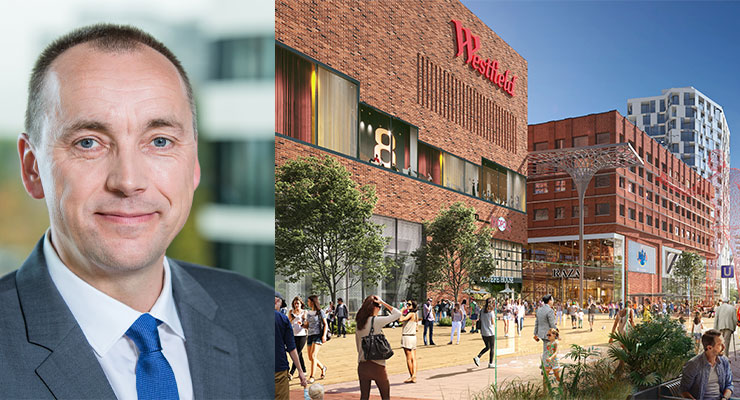ACROSS: Westfield Hamburg-Überseequartier is set to open its doors in just under six months’ time – four years after the ground-breaking ceremony in May 2019. All eyes in the industry are focusing on Hamburg. Are you beginning to get nervous?
ANDREAS HOHLMANN: Quite the opposite. Being nervous or spreading anxiety internally would send the wrong message. Plus, there is no reason to be nervous. We’re right on track.
ACROSS: The construction time was impacted by the coronavirus pandemic, which caused delays in delivery, and by the current energy crisis. The opening date has been repeatedly postponed.
HOHLMANN: COVID-19 was by far the biggest obstacle. To mention just one example, at one point during the pandemic we had sufficient staff, but not enough speed regarding the blueprints. Our globally located planners were working from home and simply unable to continue creating blueprints because no personal computer was able to handle the sheer data volume. Those were obstacles that nobody could have foreseen. However, even if construction had proceeded more quickly, regarding leasing activities: Let’s not forget that the retail industry came to a complete standstill during the pandemic. Adding the volume of the project to the equation, we actually did pretty well, considering the circumstances.
ACROSS: Can you give us a brief outline of the Überseequartier history?
HOHLMANN: The HafenCity Hamburg project, which today spans an area of several kilometers, was launched in the 1990s. It was born from the idea to move the port to the other side of the Elbe River and resulted in the construction of Europe’s largest inner-city development project (157 ha), just a few hundred meters from downtown Hamburg. A project of this kind required a number of lighthouse projects, one of which was Elbphilharmonie, another one Elbtower and, last but not least, Überseequartier in the heart of HafenCity. The quarter is buzzing with waterfront sceneries and pulsating urbanity, it provides living and working spaces and combines retail, gastronomy, and entertainment concepts. In addition we build on perfect local transport connections and several modern mobility services.
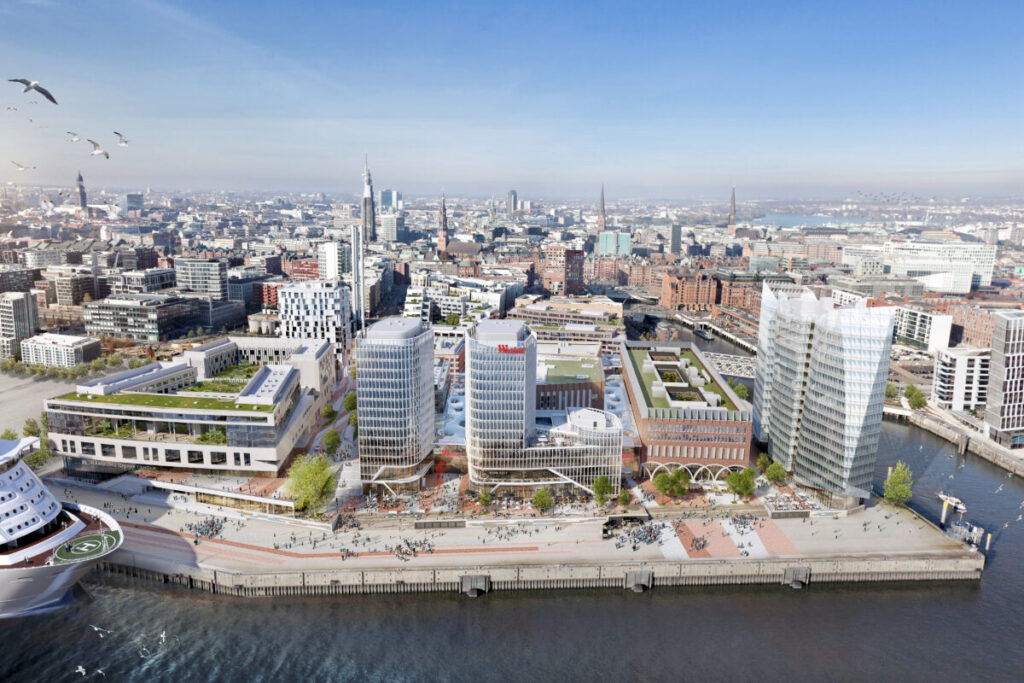
Überseequartier at a Glance
Westfield Hamburg-Überseequartier is an urban mixed-use quarter with an investment volume of approximately 1.5 billion euros. The shell construction phase began in early 2019. The opening is scheduled for spring 2024.
• Total area: 419,000 sq m
• Surface area: 269,000 sq m across 14 buildings
• Size of the site: 67,000 sq m
ACROSS: When did URW join the project team?
HOHLMANN: The first contracts were awarded under the 2006 tender. Unfortunately, they were not successful. URW started investigating the project in 2012, and we joined and reshaped the project in 2014. At that time, everyone involved, especially HafenCity GmbH, understood that a project with an investment volume of nearly €1.6bn required a larger perspective. Reshaping the project enabled us to create a total retail, dining and leisure area of 100,000 square meters. Our efforts were facilitated by our track record as attractive partners for cities in terms of urban regeneration projects. Flagship destinations within vivid urban areas, often with clear mixed-use components, are our specialty. Westfield Centro in Oberhausen, Germany, and Westfield Shopping City Süd near Vienna, Austria, are impressive evidence of how, in this cases even with smaller, local catchment area, we can still design and build large destinations that attract people from far away.
ACROSS: Your aim is to invite people to spend a day or even an entire weekend in Hamburg.
HOHLMANN: That’s correct. Similar concepts have proved successful, for example, at the Westfield Mall of the Netherlands and the Westfield Mall of Scandinavia. People often combine a shopping trip with visits to museums or musicals. For example: In the future, cruise ship tourists will arrive in Hamburg a few days before their cruise embarks in order to visit Hamburg and Westfield Hamburg-Überseequartier with its retail, dining and leisure offerings and to then comfortably board their ship right from their hotel at our quarter. That’s the concept of mixed-use retail destinations in a nutshell.
ACROSS: What is the share of retail at Westfield Hamburg-Überseequartier?
HOHLMANN: What we’re building in Hamburg is a new part of the city, including a mixed-use quarter comprised of 14 buildings, among them three residential buildings, one cruise terminal, and three hotels. Together with project development company Garbe Immobilien-Projekte, we are developing a senior community living concept. The above parts are fully leased and marketed. The offices leasing is running at full speed. For the entire quarter we talk about 419,000 sq m gross floor area. Around 100,000 sq m, that means roughly a quarter, comprise retail, food & beverage, and leisure.
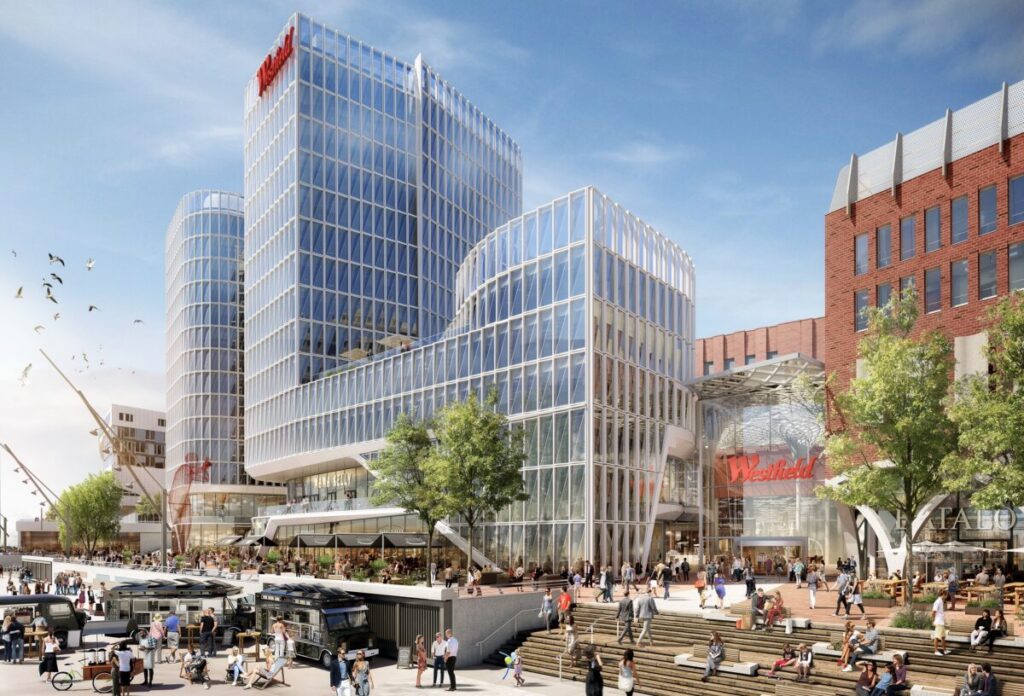
ACROSS: What criteria did you apply to the design and leasing of the retail spaces?
HOHLMANN: Five international megatrends are currently shaping the industry: premium gourmet supermarkets or market halls, differentiating food & beverage, and leisure in terms of entertainment and culture, fitness & wellness, and health & beauty. These trends are the same across the globe, keeping in line with them is a fundamental part of our work. The crucial task is to find the most suitable mix. For families, it means that the parents can go shopping or enjoy a high-quality meal while the kids are taken care of. At the end of the day, the family is reunited for a visit to the cinema. People who are focused on their health can have personalized schedules drawn up at the gym and can pop over to the supermarket to buy the healthy groceries on their lists. It is these combinations that add value to the retail industry, and implementing them is what makes us attractive to new concepts and new brands.
ACROSS: How are those concepts implemented at Westfield Hamburg-Überseequartier in concrete terms?
HOHLMANN: Our anchor tenant in the area of groceries and daily supply is a 3,000 sq m sales area REWE supermarket with a high-quality offer, including an in-house butcher’s shop and a bakery. Our aim is to provide truly exclusive offers, which is why we, together with our partner REWE, included a coffee-roasting house and a brewery in the supermarket. The second and third trends, food & beverage and leisure, together cover an area of 21,000 sq m. The quarter features more than 40 gastronomic offers, which are not clustered in a traditional food court, but have been allocated dedicated units. These are categorized by time of stay, ranging from 30 and 60 to more than 60 minutes, as well as award winning restaurants. Our gastronomic offer includes both regional cuisine as well as hot international food trends. For example, one of our key partners is Pesca, a fish restaurant form the Netherlands with a market entry in Germany. We will combine such partners with more local concepts such as Galactic, Lolas or goa. Generally speaking, the food and beverage segment has undergone a significant makeover: Today, retail and lifestyle destinations are places where people come – and stay – for a good meal. While fast food still has its merits, it is no longer the sole food offer. Our lighthouse projects in the leisure segment are a 3,400-square-meter LEGO Discovery Centre experience with several separate areas, as well as Kinopolis, a premium multiplex cinema comprising 10 halls and a total of more than 2,300 seats. In addition, Port des Lumières, a spectacular immersive digital art center, will open its doors in our quarter.
ACROSS: What about two other important trends, fitness & wellness as well as health & beauty?
HOHLMANN: In general, our gyms are more than just places to work out at. We provide nutritional counseling and an integrated wellness offer. Our partner in Hamburg is Sports Club, with a unique flagship format. The fitness studio will then be complemented by suitable retail offers, such as an Intersport Knudsen with a 2,000 sq m concept store. Regarding beauty, alongside traditional and high-quality nail studios and hair salons, we observe a growing demand for tattoo and piercing studios. This year alone, 13 new studios have signed for our 22 shopping centers in Germany and Austria. We are expecting a similar development in Hamburg. In Hamburg, we also implement a cluster with doctors’ surgeries and medical services.
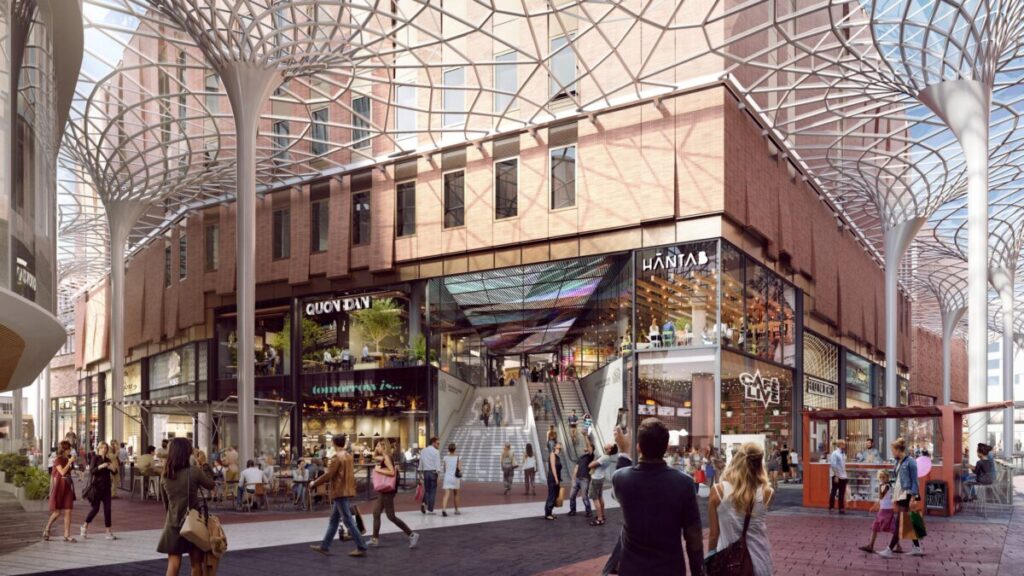
ACROSS: You said earlier that what adds value to the customer is the combination of experiences. What role do omni-channel approaches play in that respect?
HOHLMANN: A very important one. Let me give you an example: Fashion retailer Breuninger is opening a 14,000-square-meter shop at the quarter, making Westfield Hamburg-Überseequartier their first location in northern Germany. For Breuninger, this is a strategic move to not only attract customers to their store, but also strengthen the consumers’ brand affinity for promotion of its digital offer in the north. In general, this is what we call the halo effect, the halo being the store that radiates out into the world. Attractive brick and mortar retail and online sales are closely interlinked. It goes without saying that omni-channel offers are also requested of us. Continuously developing such offers is pivotal to the attractiveness of any given location, especially if such location represents far more than traditional retail.
ACROSS: The example of Breuninger illustrates that Westfield Hamburg-Überseequartier mainly focuses on large spaces.
HOHLMANN: We will also have mid size and smaller units. But with regard to the large flagship stores that’s correct. We are attracting concepts that would not find their way to Hamburg, were it not for the Westfield Hamburg Überseequartier. Size and location are decisive factors. This trend has been apparent for roughly five years: Large, international brands require flagship stores. URW has adapted its strategy to this demand. Our company focuses on a compact number of big locations where we can offer the large spaces required. Inditex, H&M, and Breuninger alone cover a combined retail space of approximately 30,000 square meters at Westfield Hamburg-Überseequartier. An average German shopping center covers an area of roughly 25,000 sq m. The value of a shopping center is determined by the combination of small and large stores, as well as the interrelation between those generating the footfall and those benefiting from it. The larger the formats of the brands generating the footfall are, the larger the size of the overall concept – that’s the secret to the right mix. Today, size definitely matters in terms of attractiveness.
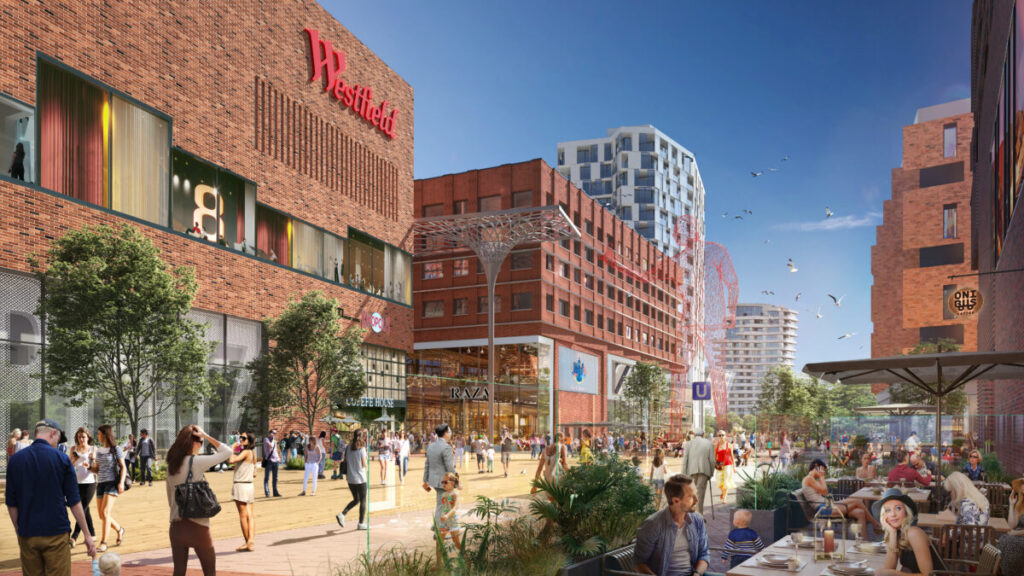
ACROSS: You’re boasting a pre-occupancy rate of a whopping 85%. What about the remaining space?
HOHLMANN: They require what we call pearl diving. All large, international brands have been allocated their large spaces. Smaller concepts require a bit more time. Now is a good time to attract some concepts that have not been around to date, for example, small, sustainable, and regional players. Thanks to our size, we have the opportunity to try out newcomers that fit in well with our overall ideas. This is when our white-box model comes into play: We fit out stores that have a size of approximately 100 square meters and offer them at a lower rent to small businesses that we believe in. Those companies normally don’t have the funds to fit out their own stores and cover high rents, but their ideas and products are great, and they add a special something to the quarter. They offer the customers something they haven’t seen yet. Sustainable brands are a key component in this approach: In this context, we can also use the Westfield Grand Prix, for example. A competition that we as URW organize, in which we look for sustainable start-ups in the fields of retail, F&B, leisure, health and well-being. The winner then receives rent reductions for a unit in one of our Westfield destinations.
ACROSS: Good traffic infrastructure is essential to footfall. What’s your approach in this regard?
HOHLMANN: Traffic infrastructure is a vital element of the sustainable operation of properties. A shopping center’s CO2 emission is predominantly driven by the means of transport customers use to get there. It is our responsibility to find sustainable solutions for every one of them. Our parking garage at Westfield Hamburg Überseequartier is fitted with up to 320 e-chargers for customers, residents and office workers arriving in their electric cars. We provide dedicated parking space for 3,500 bicycles. There are two bus routes along the quarter. The direct access to the “Überseequartier” subway stop was already in place. That was a key element in our decision for the location. We work closely with Hamburger Hochbahn, Hamburg’s transportation company, or with Moia, a ridesharing service. Generally speaking, URW no longer operates assets that do not have public transport connections. Sustainable and community-oriented mobility is a key element in our ‘Better Places’ sustainability strategy. What’s important now is creating options for customers to transport their shopping if they choose to leave their cars at home. Enter the aforementioned omni-channel solutions: we use click & collect and ship-from store solutions together with our partners in order to offer the best services for our customers.
ACROSS: Will the grand opening of Westfield Hamburg-Überseequartier next spring be the last major opening in Europe?
HOHLMANN: I’m sure that Westfield Hamburg Überseequartier will remain the last major opening for quite some time to come, not least because no other major European city has sufficient space in its center. I do believe, however, that massive investment will be required in the future when it comes to existing properties. With retailers requiring significantly more space, many locations will have to invest in comprehensive refurbishment in the short and medium term in order to remain attractive to top international brands.
ACROSS: What does that mean for URW?
HOHLMANN: The amount that, only 15 years ago, we invested in the construction of a new shopping center, is now required every year for the development and modernization, also in terms of sustainability, of our locations in Germany and Austria. Every single location must take the aforementioned megatrends seriously if it aims to remain attractive to major brands. Our portfolio illustrates that fact nicely. In 2015, a state-of-the art concept was applied to the opening of the Westfield Mall of Scandinavia. We adopted the entire concept and developed it even further for the Westfield Mall of the Netherlands. Westfield Hamburg-Überseequartier has reached yet a higher level, tailored to the specific requirements of its Hamburg location – and of course also in the context of a mixed-use development. We are sure that we will remain state of the art for years to come.
Retail, F&B and entertainment balanced with apartments, offices, hotels and a cruise terminal
| Retail 80,500 sq m gross floor area on 4 levels, around 200 spaces (including leisure and gastronomy) | Culture, Leisure, Entertainment and Dining 21,000 sq m, more than 40 gastronomy and food concepts |
| Offices 48,000 sq m , 3 building types with 4 buildings | Hotels 3 hotels offering a total of 810 rooms, total area: 40,000 sq m |
| Cruise Terminal 10,000 sq m | Residential total of 579 apartments, total area: 55,000 sq m |
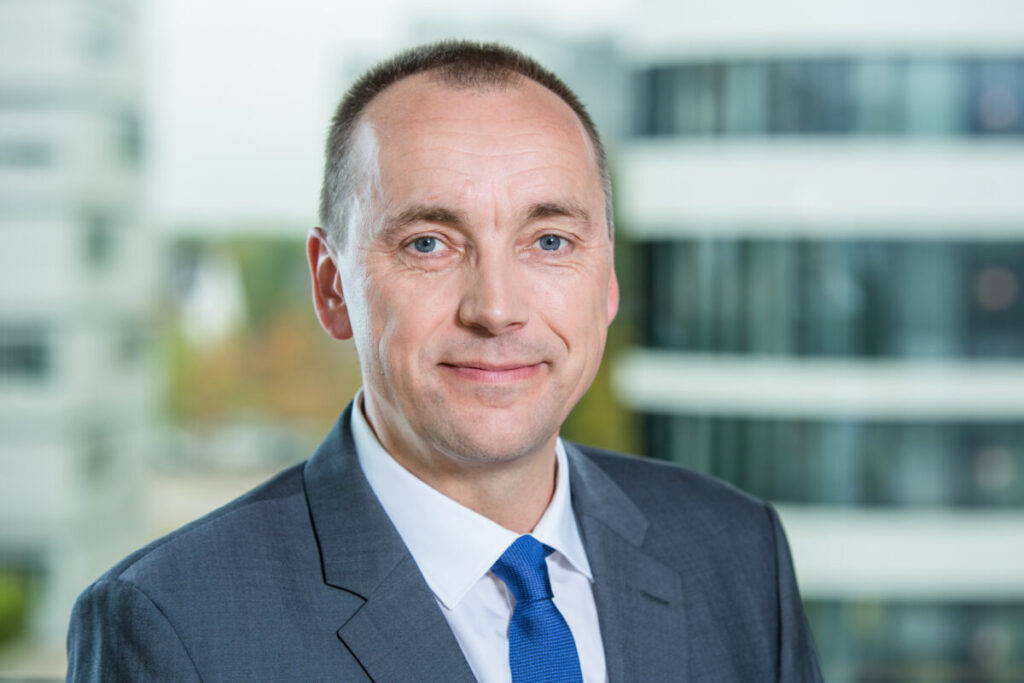
Andreas Hohlmann
Andreas Hohlmann is Managing Director Austria & Germany at Unibail-Rodamco-Westfield

